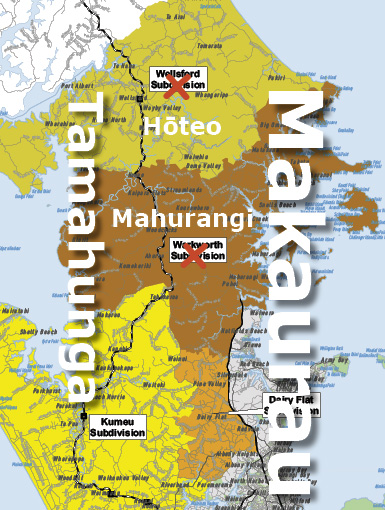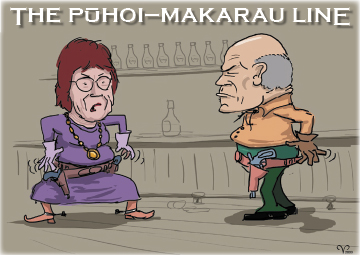As a name for the region, Auckland is wrong

Riding Roughshod: At least the royal commission got right the need to replace Rodney with an indigenous name. The commission was not responsible for the unfortunate term subdivision; riding retains the nice historical ring. Underlying Map Local Government Commission
The sloppy language slipped in at the beginning. Whereas its terms of reference diligently referred to the Auckland region, that key word was omitted from its very name: Royal Commission on Auckland Governance.
Then the commissioners themselves were careless of the important distinction between Auckland and Auckland region, right from their first media release, and the very few that followed—twelve Aucklands and one solitary Auckland region.
This helped muddy the waters for Mahurangi, fueling the misapprehension that the rural was about to be subsumed by the urban—Mahurangi has been part of the Auckland region for 56 years and is rural because of, not despite, that. It has benefited greatly by protection from coastal sprawl and from the work to reduce the sediment accumulation rate.
To be fair to the commissioners, they were not the first to miss the boat. The establishment of the first region-wide planning authority, in 1954, was the perfect time to pass over Auckland, a relic of colonial patronage, in favour of an indigenous name for the region.
One indigenous name for the isthmus, of course, is Tāmaki-makau-rau. As wonderful a name as it is, it is too specific in location, and at six syllables too long, to serve well as the name for the region. Tāmaki has been compromised by becoming localised, to the suburb of that name. That leaves the melodic Makaurau, which can be taken to mean ‘favoured by many’. As an entirely fresh, positive name and elsewhere-unused name, it is an absolute gift as the name of the region and its new council.
In naming its recommended new single structure for the region, the royal commission was derelict in deciding upon the phlegmatic Auckland Council. Auckland Council was too close to the existing Auckland City Council to ever usefully differentiate it. And waiting in the wings, was Super City, with its all alluring alliteration and sufficiently pejorative to play straight into the hands of single city detractors—and sneered with as much offence but more impunity than Jafa. The Auckland region does not remotely fit the definition of supercity: A large, heavily populated urban area that includes several cities; megalopolis. The world’s megalopolises, great cities, have populations in the order of 10 million. At fewer than 1.5 million, the vast majority of its residents will be more than content for Makaurau to never be a supercity—for its Super City moniker to remain forever a misnomer.
While its citizens have every reason to enjoy a pride of place, provincial chips on shoulders are only going to become more pronounced with every Super City or greater Auckland pronouncement. By eschewing the superlatives and embracing its natural indigenous name, Makaurau could demonstrate agreeable humility and preparedness to share, not hog, the limelight. But if the region did adopt its natural name Makaurau, it raises the need to develop an appropriate demonym for its citizens. Auckland easily rendered Aucklander. The most common device is to add the letter ‘n’, which would make for a less than magical Makauraun. The –ian suffix renders a cumbersome Makaurauian, but shortened to Makaurian might be manageable and nicely Polynesian sounding. (To square the use of Makaurian with Pakistan, Chah Makaurian might need to be made a sister city—who’s counting, the Auckland region has already accumulated 20 ‘sister cities’!) Perhaps some talented toponymist could coin something approaching the charm of that darling of demonyms: Liverpudlian.
At the local level, despite the royal commission signalling the need for a Māori name to replace it, the new arrangements retain Rodney as the name of both the ward and the local board. Adding insult to injury, the subdivisions of Rodney Local Board are named Wellsford, Warkworth and, of which they got one almost right, Kumeu—Kumeū. Tamahunga is the obvious name for ward and board, given the dilemma of choosing between the other two major geographic contenders, the harbours of Kaipara and Mahurangi.
The subdivisions are immeasurably more taxing, making compromise inevitable—Hōteo for Wellsford and Mahurangi for Warkworth. Although its mouth misses out, the catchment of the mighty Hōteo makes up most of the subdivision. Mahurangi was once used to describe an area much larger than the harbour and catchment, although it never extended to the Kaipara shoreline. The alternative, Warkworth, is inappropriate and further fuels existing jealousies. (Changing from misnomer hobbyhorse midstream to nomenclature: Ditch subdivision in favour of the delightful riding—etymological misapprehension and all.)

Old Animosities: By failing to participate constructively in the design of the new governance arrangments for the region, the Rodney District Mayor put the Mahurangi and Hōteo at risk. cartoon Majorlook Productions
All these are issues that the Rodney district councillors and mayor might have addressed, had the majority not been obsessed with secession. In Alternatives to Amalgamation in Australian Local Government: Lessons from the New Zealand Experience, Brian Dollery warns
In effect, the old community political structures and local sentiments never died with the amalgamation process, but were simply transformed into community boards or community committees. As a consequence, old animosities generated by the bitterness surrounding forced amalgamation often surfaced and subsequently poisoned relationships between new council organisations and the old community structures.
Come 23 July, when nominations open, it is likely that the mayor and those councillors who voted to separate, as a unitary authority, will happily throw their hats into the Auckland Council ring. Election of these separatists would be unfortunate because their motivation will be to prove their stance was justified, rather than do the hard yards needed to make the new structure work.
It is to be hoped that there will be candidates who have constructively contributed to the new Auckland region governance arrangements. For this reason it is important that candidates for the Rodney Ward include regional councillor Christine Rose. Prior to serving on the regional council, Mrs Rose served as a Rodney district councillor and understands the degree to which the Mahurangi has been protected from coastal sprawl. Mrs Rose has energetically supported the action to reduce the sediment accumulation rate in the harbour, even narrating the video Mahurangi Action Plan: Weaving Science and Community into Action.
There are to be three local board representatives of the Warkworth subdivision, but so far the only one person to has signalled an intention to stand, Rodney district councillor June Turner. Mrs Turner is of the unitary authority persuasion and has contributed nothing to the new structure. With nominations not closing until 20 August, there is time for at least one candidate to emerge who understands the need for regional planning.
Meantime this magazine will beat a drum: Auckland, Rodney and Warkworth are wrong, much better it be Makaurau, Tamahunga and Mahurangi…
…Mahurangi a million miles from the metropolis.
